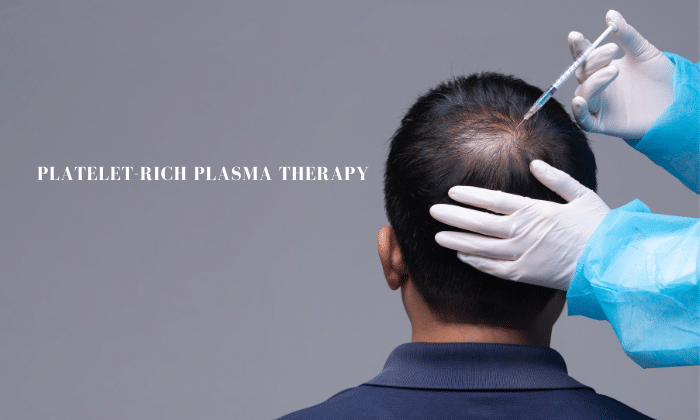You may have heard about platelet-rich plasma therapy. Platelet-rich plasma therapy, also called PRP therapy is an increasingly popular treatment for hair loss. Hair loss or thinning hair are common problems across genders. About 50 million men and about 30 million women have lost some hair. Hair loss is especially common after the age of 50 or due to certain conditions, such as stress.
For those who experience hair loss, life can be daunting. Hair loss can result in a poor self-image and even low self-esteem. Also, the way other people treat you if you have hair loss, may result in your shying away from social situations or worse.
There are different types of hair loss. PRP therapy is typically used to treat androgenetic alopecia, also called male pattern baldness. This condition is quite common and in this condition, the hair follicles shrink. There are several hundreds of different hair loss treatments with varying levels of success and reliability. One such treatment is PRP therapy.
Some doctors think that PRP injections trigger natural hair growth and maintain it by increasing blood supply to the hair follicle and increasing the thickness of the hair shaft. Quite often, PRP therapy is carried out in combination with other hair loss procedures and medications. However, more research needs to be carried out to determine whether PRP therapy is an effective hair loss treatment.
The PRP Therapy Process
Typically, PRP therapy is a three-step process. Most PRP therapy requires three treatments about 4 to 6 weeks apart. Maintenance treatments are required every 4 to 6 months.
- Step 1: Your blood is drawn, typically from your arm and then put into a centrifuge. The latter is a machine that spins rapidly to separate fluids of different densities.
- Step 2: After about 10 minutes in the centrifuge, your blood will have separated into three layers – platelet-poor plasma, platelet-rich plasma, and red blood cells.
- Step 3: The platelet-rich plasma is drawn into a syringe and then injected into those areas of the scalp that require increased hair growth.
How PRP therapy works
Platelets are a component of blood along with red blood cells and white blood cells. Platelets promote healing and when a person sustains a cut or a wound, platelets are some of the body’s “first responders” that arrive to stop the bleeding and promote healing.
Due to this “healing” role of platelets, researchers and doctors theorized that if they could extract concentrated platelets and inject them into damaged areas of the body, they could accelerate healing.
PRP contains a number of proteins and growth factors that result in, and speed up, tissue repair. In androgenetic alopecia, hair loss results from damage to hair follicles. Researchers hypothesized that PRP could help regrow hair by reversing this process. PRP therapy could also work by the platelets reaching the bottom of the hair follicles and may stimulate a specialized population of cells called dermal papilla cells, which play a critical role in hair growth.
Is PRP therapy effective?
In 2019, researchers carried out a systematic review of the research on PRP, and investigated the procedure as a treatment for hair loss. Their findings appear in the Aesthetic Plastic Surgery journal. The analysis focused on 11 research papers that included a total of 262 participants with androgenetic alopecia. Most of the studies found that injections of PRP reduced hair loss, increased the diameter of hairs, and increased the density of hair growth.
Other studies have also been conducted, which concluded that PRP therapy is an effective treatment for androgenic alopecia and alopecia areata. The latter occurs when the immune system attacks hair follicles. However, these studies also cautioned that because various researchers and varied clinics use different preparations, session intervals, and injections techniques to administer PRP, its effects can vary.
How long does the effect of PRP therapy last?
PRP therapy is not a cure for the conditions that cause hair loss. For this reason, a person would need to receive multiple PRP treatments over a period of time to maintain hair growth results. How often a person should have PRP therapy will depend on a person’s condition and the results of their initial treatment. The doctor may suggest having maintenance injections every 3 to 6 months.
When you should not have PRP therapy
Your cosmetic surgeon may advise you against PRP therapy if you are on blood thinners, are a heavy smoker, or have a history of alcohol and drug misuse. You may also be rejected for PRP therapy if you have acute or chronic infections; cancer; chronic liver disease; chronic skin disease; hemodynamic instability; metabolic disorder; platelet dysfunction syndromes; systemic disorder; sepsis; low platelet count, and thyroid disease.
You should have an honest and detailed consultation with your cosmetic surgeon before deciding to opt for this therapy. Dr. S. Suma, of prettyu.com, is a skilful and empathetic surgeon who will work closely with you and will determine if you are the right candidate for PRP therapy.
She will prepare you both physically and psychologically for the procedure and will explain the entire process to you and will answer all your questions and will address all your concerns. So, if you are concerned about your hair loss, do consult with Dr. S. Suma and rest easy, knowing you will receive the best treatment possible for you!
To know more about Platelet-rich Plasma (PRP) Therapy, as well as the other cosmetic and reconstructive surgery procedures that Dr. S. Suma performs, you can get in touch with her at +91 86 86 042 042 or email her at info@prettyu.com or visit her website. Get to the Prettiest Version of YOU. By the prettiest hands in Hyderabad.

